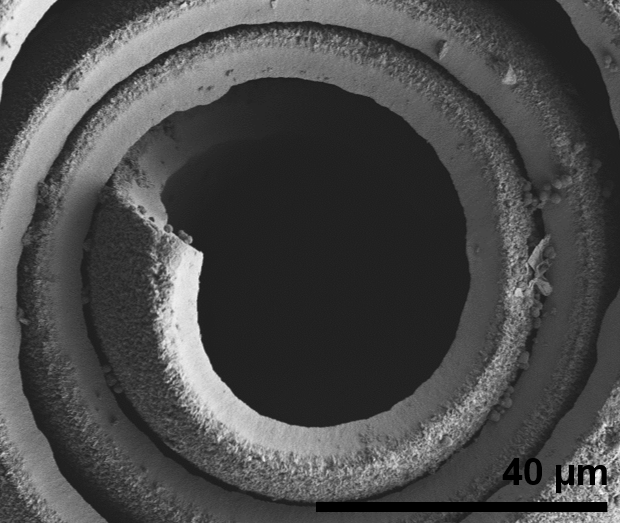Bio-inspired synthetic strategies towards mesostructured functional materials
Living organisms can exert an astonishing degree of control over the size, shape, texture and even polymorph of mineral crystals by relying on sophisticated self-assembly processes. While Nature’s dexterity in using structure-directing organic matrices and confined reaction environments to generate bio-inorganic hybrid materials with internal interfaces on the nanometer level remains largely unmatched in synthetic systems, substantial progress has been made over the last years in translating some key concepts of biological mineralization into artificial materials. This clearly opens exciting new perspectives for eco-efficient materials synthesis, as biological and bio-inspired mineral deposition invariably proceeds in aqueous medium and at low temperature.
Unsurprisingly, bio-inspired mineralization routes are particularly well-established for the controlled precipitation of calcium carbonates (Figure 1), calcium phosphates, and silicates, all of which represent mineral systems abundant in biological materials. In this context, the study of in-vitro model systems with a reduced degree of complexity can make a strong contribution to our understanding of biological mineral deposition processes and the critical parameters that control them.

Figure 1: Bio-inspired calcium carbonate particles with unusual morphologies. A) Mineral fibres generated by deposition of calcium carbonate in the presence of an amine-functionalized polymer as a structure-directing agent. B) Porous mineral films formed by accretion of peptide-stabilized amorphous nanoparticles. C) Single-crystalline rod of vaterite - a metastable polymorph of calcium carbonate -grown within the confinement of cylindrical track etch membrane pores (Ø = 200 nm).

Figure 2: Coiled mineral film formed by polyethylenimine-mediated cobalt hydroxide carbonate deposition followed by calcination.
In the chemical laboratory, guiding principles of biological mineralization can be used for the preparation of structured materials that combine complex architectures with intrinsic physical or physicochemical functionalities (e.g. optical, electronic or catalytic).
In this area, our work has recently explored a bio-inspired approach, in which a thermally unstable cobalt hydroxide carbonate precursor is precipitated from aqueous solution in the presence of biotemplates or synthetic water-soluble polymer additives. Calcination converts the precursor into the Co3O4 – a functional material -, while retaining the gross morphology induced by the structure-directing agents. We have demonstrated that highly unusual Co3O4 structures such as (curly) thin films (Figure 2), hollow microspheres or micrometer-sized tubular superstructures composed of nanoparticles can be obtained based on bio-inspired concepts.
For further information see:
- Anna S. Schenk, Harshal Zope, Yi-Yeoun Kim, Alexander Kros, Nico A.J.M. Sommerdijk, Fiona C. Meldrum, Polymer-induced liquid precursor (PILP) phases of calcium carbonate formed in the presence of synthetic acidic polypeptides ̶ Relevance to biomineralization., Faraday Discussions 2012, 159, 327-344.
- Anna S. Schenk, Bram Cantaert, Yi-Yeoun Kim, Yuting Li, Elizabeth S. Read, Mona Semsarilar, Steven P. Armes, Fiona C. Meldrum, Systematic Study of the Effects of Polyamines on Calcium Carbonate Precipitation, Chemistry of Materials 2014, 26 (8), 2703-2711.
- Anna S. Schenk, Sabine Eiben, Miriam Goll, Lukas Reith, Alex N. Kulak, Fiona C. Meldrum, Holger Jeske, Christina Wege, Sabine Ludwigs, Virus-directed formation of electrocatalytically active nanoparticle-based Co3O4 tubes, Nanoscale 2017, 9, 6334 - 6345.
- Vanessa J. Neubauer, Christine Kellner, Viktoria Grün, Anna S. Schenk, Thomas Scheibel, Recombinant Major Ampullate Spidroin-Particles as Biotemplates for Manganese Carbonate Mineralization, Multifunctional Materials 2021, 4, 014002.
- Viktoria Gruen, Nicolas Helfricht, Sabine Rosenfeldt, Anna Schenk, Interface-mediated formation of basic cobalt carbonate/polyethyleneimine composite microscrolls by strain-induced self-rolling, Chemical Communications 2021, 10.1039/D1CC01136G.
